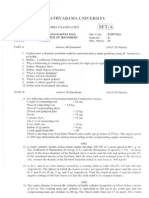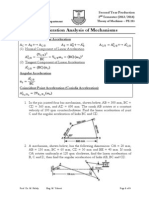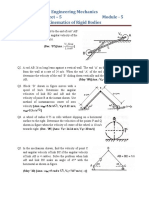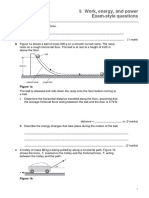DOM Unsolved Problem
Uploaded by
Ankush LaybarDOM Unsolved Problem
Uploaded by
Ankush LaybarUniversity Asked Question
SUMMER-2024
Q.1 b) A four-link mechanism with the following dimension
is acted upon by the force as shown in figure. AD = 150 mm,
AB = 400 mm, BC = 1000 mm, DC = 750 mm, and DE = 350
mm. Determine the input torque on the link AB for the static
equilibrium of the mechanism. (10)
Solution: Similar Problem 1.24 on Page 1-61.
Q.2 b) Slide crank mechanism is shown in figure. (9)
Determine the forces on the various links
Also calculate torque T2.
Solution:
Q.3 a) In a slide crank mechanism, the length of the crank
and connecting rod are 150 mm and 600 mm respectively.
The crank position is 60 from inner dead center. The crank
shaft speed is 450 r.p.m. (clockwise). Using analytical
method,
Determine:
1. Velocity and acceleration of the slider,
2. Angular velocity and angular acceleration of the
connecting rod. (6)
Solution:
Q.4 a) A petrol engine 90 mm in diameter and 120 mm
stroke has a connecting rod of 240 mm length. The piston
has a mass of 1 kg and the speed is 1800 r.p.m. One the
explosion stroke with the crank at 30 from top dead
center, the gas pressure is 0.5 N/ mm2. (8)
Find,
1. The resultant load on the gudgeon pin,
2. The thrust on the cylinder walls, and
3. The speed, above which other things remaining same,
the gudgeon pin load would be reserved in direction. Also
calculate the crack effect at the given position of the crank.
Solution:
Prof. Anit Pendhari 7-41
University Asked Question
Q.5 b) The heavy turbine rotor of a sea vessel rotates at
1500 r.p.m. clockwise looking from the stern, its mass
being 750 kg. The vessel pitches with an angular velocity of
1 rad/s. Determine the gyroscopic couple transmitted to
the hull when bow is rising, if the radius of gyration for the
rotor is 250 mm. also shown in what direction the couple
acts on the hull. (7)
Solution:
WINTER-2024
SECTION - A
Q.2 a) In a four bar mechanism shown in the figure, torque
T3 and T4 have magnitudes of 30N-m and 20N-m
respectively. The link lengths bare AD = 800 mm. AB = 300
mm, BC = 700 mm and CD = 400 mm. By applying principle
of Superposition, determine the magnitude and the direction
of the required input torque T2 to be applied on link AB, for
the static equilibrium of the mechanism. (10)
Solution: Solved as Problem 1.1 on Page 1-14.
Q.3 a) The following data relate to a horizontal reciprocating
engine: (10)
Mass of reciprocating parts = 120kg
Crank length = 90mm, engine speed = 600 rpm.
Connecting rod mass = 90kg.
Length between centers = 450mm,
Distance of center of mass from big and center = 180mm,
Radius of gyration about an axis through center of mass =
150mm
Find, by Klein’s construction, the magnitude and the
direction of the inertia torque on the crankshaft when the
crank has turned 30 from the inner dead centre.
Solution:
Q.8 a) The measurements on a mechanical vibrating system
shows that it has a mass of 8 kg and that the springs can be
combined to give an equivalent spring that deflects through
0.5 mm on application of 2.7N force. If the vibrating system
has a dashpot attached which exerts a force of 10 N when the
mass has a velocity of 0.25 m/s.
Find:
i) Critical damping coefficient,
ii) Damping factor,
iii) Logarithmic decrement, and
iv) Ratio of two consecutive amplitudes. (7)
Solution:
Q.10 b) A shaft 50mm diameter and 3 meters long is simply
supported at the ends and carries three loads of 1000N,
1500N and 750N at 1m, 2m, and 2.5m from the left support.
The Young’s modulus for shaft material is 200Gn/m 2. Find
the frequency of transverse vibration. (7)
Solution: Solved as Problem 5.21 on Page 5-53.
Prof. Anit Pendhari 7-42
You might also like
- MODULE 5 DYNAMIC FORCE ANALYSIS - FinalNo ratings yetMODULE 5 DYNAMIC FORCE ANALYSIS - Final22 pages
- A1 Assignments On Static Force Analysis and Dynamic Analysis of Slider Crank MechanismNo ratings yetA1 Assignments On Static Force Analysis and Dynamic Analysis of Slider Crank Mechanism15 pages
- Our Official Android App - REJINPAUL NETWORK FromNo ratings yetOur Official Android App - REJINPAUL NETWORK From3 pages
- Dec 2019 ME304 - Dynamics of Machinery (S) - Ktu QbankNo ratings yetDec 2019 ME304 - Dynamics of Machinery (S) - Ktu Qbank3 pages
- 2020-10-08SupplementaryME304ME304-G - Ktu QbankNo ratings yet2020-10-08SupplementaryME304ME304-G - Ktu Qbank3 pages
- Instructions:: Gujarat Technological UniversityNo ratings yetInstructions:: Gujarat Technological University2 pages
- Dynamics of Machinery: III B. Tech I Semester Supplementary Examinations, May - 2019No ratings yetDynamics of Machinery: III B. Tech I Semester Supplementary Examinations, May - 20192 pages
- Question Bank _ 10 Mark _ MEPC 503 Theory of MachinesNo ratings yetQuestion Bank _ 10 Mark _ MEPC 503 Theory of Machines4 pages
- MODULE 5 DYNAMIC FORCE ANALYSIS - FlywheelNo ratings yetMODULE 5 DYNAMIC FORCE ANALYSIS - Flywheel36 pages
- 10 Exercise 5 Acceleration Analysis of MechanismsNo ratings yet10 Exercise 5 Acceleration Analysis of Mechanisms5 pages
- ME8594 Dynamics of Machines 01 - by LearnEngineering - in PDF0% (1)ME8594 Dynamics of Machines 01 - by LearnEngineering - in PDF128 pages
- Module 5 Kinematics of Rigid Bodies Common QuestionsNo ratings yetModule 5 Kinematics of Rigid Bodies Common Questions7 pages
- Module 5 Kinematics of Rigid Bodies Common QuestionsNo ratings yetModule 5 Kinematics of Rigid Bodies Common Questions7 pages
- Course Sem 3 Business Communication Processes and WorkflowsNo ratings yetCourse Sem 3 Business Communication Processes and Workflows258 pages
- Course Sem 5 Business Communication Documentation (2)No ratings yetCourse Sem 5 Business Communication Documentation (2)262 pages
- Course Sem 4 Business Communication Complaints and GrievancesNo ratings yetCourse Sem 4 Business Communication Complaints and Grievances294 pages
- Sant Gadge Baba Amravati University Gazette - 2018 - Part Two - 267No ratings yetSant Gadge Baba Amravati University Gazette - 2018 - Part Two - 26718 pages
- Electric Traction MCQ Questions & Answers - Electrical EngineeringNo ratings yetElectric Traction MCQ Questions & Answers - Electrical Engineering3 pages
- DM - 02 - 02 - Descriptive Data SummarizationNo ratings yetDM - 02 - 02 - Descriptive Data Summarization32 pages
- Huygens Principle and Laws of Rfraction and ReflectionNo ratings yetHuygens Principle and Laws of Rfraction and Reflection6 pages
- Kinematics Multiple Choice Review QuestionsNo ratings yetKinematics Multiple Choice Review Questions15 pages
- Questions of Oscillation and InterferenceNo ratings yetQuestions of Oscillation and Interference3 pages
- Spotlight - Batch-II (2023-24) - Day-8 - DPP - Physics - (Only Que.)No ratings yetSpotlight - Batch-II (2023-24) - Day-8 - DPP - Physics - (Only Que.)5 pages
- Bunday_tutorial_Phy101_Kinematics_practice_qstsNo ratings yetBunday_tutorial_Phy101_Kinematics_practice_qsts3 pages
- Proportional Navigation Guidance (Cite:john H Blakelock)No ratings yetProportional Navigation Guidance (Cite:john H Blakelock)7 pages
- Selection Guide (Gripping Force) : RCP2 SeriesNo ratings yetSelection Guide (Gripping Force) : RCP2 Series5 pages
- Lecture03 - 08-05-2023 (Wave Packets GP and VP)No ratings yetLecture03 - 08-05-2023 (Wave Packets GP and VP)35 pages
- 8L Sound and Hearing Multiple Choice TestNo ratings yet8L Sound and Hearing Multiple Choice Test3 pages
- Introduction To Trigonometry PYQS On Latest SyllabusNo ratings yetIntroduction To Trigonometry PYQS On Latest Syllabus8 pages



































































































